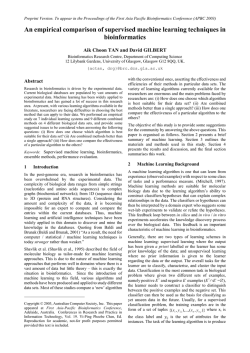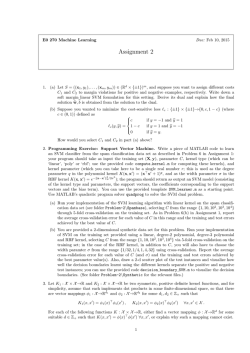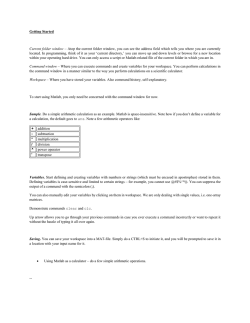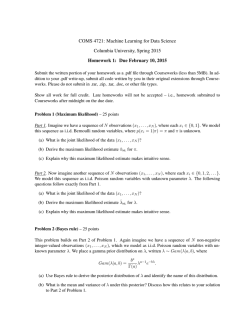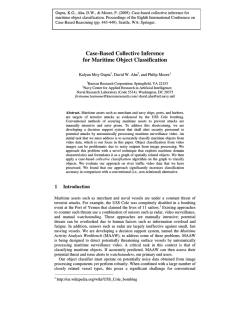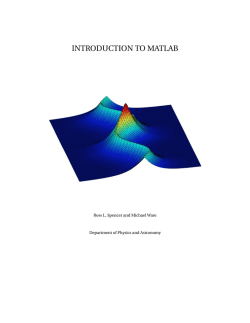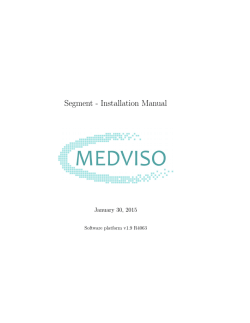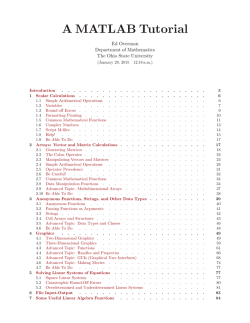
HW1
Homework 1, due Monday February 9
COMS 4771 Spring 2015
Problem 1 (Classifiers via generative models). Download the OCR image data set mnist.mat
from Courseworks, and load it into MATLAB. The unlabeled training data (i.e., feature vectors)
are contained in a matrix called data (one point per row), and the corresponding labels are in
a vector called labels. The test feature vectors and labels are in, respectively, testdata and
testlabels. To view the i-th image in the training data, use the following command:
imagesc(reshape(data(i,:),28,28)’);
If the colors are too jarring for you, try the following:
colormap(1-gray);
1. Write a MATLAB function that takes as input a matrix of training feature vectors X and a
vector of labels Y (as data and labels above), and returns the parameters params of the
plug-in classifier based on multivariate Gaussian class conditional densities.
function params = hw1 train1a(X,Y)
You should use the MLE for estimating the class priors, as well as the means and covariances
for each class conditional density. You can collect all of these parameters in a MATLAB
struct (or anything else that works). Don’t bother optimizing this; just get something that
works correctly.
Also write a MATLAB function that takes as input the parameters of the above plug-in
classifier params, and a matrix of test feature vectors test. The function should output a
vector of predictions preds for all test feature vectors.
function preds = hw1 test1a(params,test)
Before applying hw train and hw test to real data, it’s often a good idea to test out your code
on an easy problem where you know what to expect. Download the data set hw1 data.mat,
also available on Courseworks. This data are drawn from a distribution over R2 × {0, 1, 2}
where the class prior is uniform, and the class conditional densities are bivariate Gaussians
N ((0, 2), I), N ((0, 0), I), N ((2, 0), 0.25I); the MATLAB function used to produce these data
is also on Courseworks. Apply hw1 train1a to the training data (data and labels) to get a
classifer, and evaluate it on the test data (testdata and testlabels) using hw1 test1a.
In your write-up, just report the training error and the test error from above.
2. Now apply hw1 train1a to the OCR training data, and evaluate the resulting classifer on the
test data using hw1 test1a. Something bad should happen, even if your code is correct. Try
to explain what goes wrong.
3. Create new versions of hw1 train1a and hw1 test1a so that now the class conditional distributions are multivariate Gaussians with a fixed covariance matrix that is always equal to
the identity matrix. (Call the new functions hw1 train1b and hw1 test1b.) Use these new
functions to train a classifer and evaluate it on the test data. In your write-up, report the
training error and the test error, and explain why you don’t encounter the same problem
encountered earlier.
1
Problem 2 (Nearest neighbors). Write a MATLAB function that implements the 1-nearest neighbor classifier. Your function should take as input a matrix of training feature vectors X and a vector
of labels Y (just as in Problem 1), as well as a matrix of test feature vectors test. The output
should be a vector of predicted labels preds for all the test points.
function preds = hw1 nn(X,Y,test)
Load the OCR image data set from Problem 1. Instead of using hw1 nn directly with data and
labels as the training data, do the following. For each value n ∈ {1000, 2000, 4000, 8000},
• Draw n random points from data, together with their corresponding labels.
• Use these n points as the training data with hw1 nn, with testdata as the test points, and
compute the resulting test error.
A plot of the test error (on the y-axis) as a function of n (on the x-axis) is called a learning curve.
Since the above process involves some randomness, you should make repeat it independently
several times (say, at least ten times). Produce a learning curve plot using the average of these test
errors (that is, averaging over the repeated trials). Add error bars to your plot that extend to one
standard deviation above and below the mean.
Problem 3 (Classification with different costs). Suppose you face a binary classification problem
with input space X = R and output space Y = {0, 1}, where it is c times as bad to commit a “false
positive” as it is to commit a “false negative” (for some positive number c > 0). To make this
concrete, let’s say that if your classifier predicts 1 but the correct label is 0, you incur a penalty of
$c; whereas if your classifier predicts 0 but the correct label is 1, you incur a penalty of $1. (And
you incur no penalty if your classifier predicts the correct label.)
Assume the distribution you care about has a class prior with Pr(Y = 0) = 2/3 and Pr(Y =
1) = 1/3, and the class conditional densities are N (0, 1) for class 0, and N (1, 1/4) for class 1. What
is the classifier f ? : R → {0, 1} that has smallest expected penalty? Your answer should be given
in terms of c.
2
© Copyright 2026
